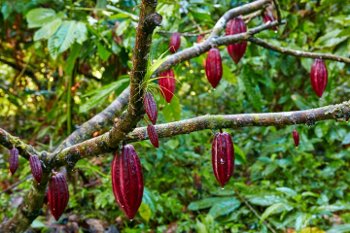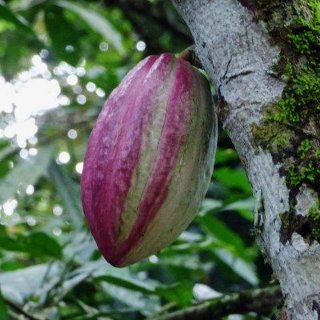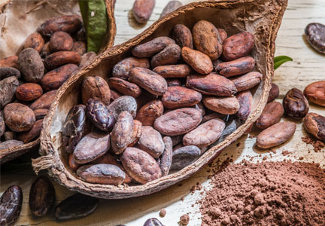Contents:
Common Names | Parts Usually Used | Plant(s) & Culture | Where Found | Medicinal Properties | Biochemical Information
Legends, Myths and Stories | Uses | Formulas or Dosages | Nutrient Content | How Sold | Warning | Resource Links | Bibliography
Scientific Names

- Theobroma cacao
- Malvaceae family
Common Names
- Beurre de Cacao
- Cacao tree
- Cocoa Bean
- Cocoa Butter
- Cocoa Oleum
- Cocoa Seed
- Cocoa Semen
- Cocoa Testae
- Cocoa tree
- Chocolat
- Chocolat Noir
- Chocolate tree
- Dark Chocolate
- Dutch Chocolate
- Fève de Cacao
- Graine de Cacao
- Theobroma
- Theobroma cacao
- Theobroma sativum
- Théobromine
Parts Usually Used
The seeds, cocoa beans, are used to make chocolate liquor, cocoa solids, cocoa butter and chocolate.

Description of Plant(s) and Culture
The cocoa tree, is a small (4–8 m (13–26 ft) tall) evergreen tree whose leaves are alternate, entire, unlobed, 10–40 cm (3.9–15.7 in) long and 5–20 cm (2.0–7.9 in) broad.
The flowers are produced in clusters directly on the trunk and older branches; this is known as cauliflory. The flowers are small, 1–2 cm (0.39–0.79 in) diameter, with pink calyx. The fruit, called a cacao pod, is ovoid, 15–30 cm (5.9–11.8 in) long and 8–10 cm (3.1–3.9 in) wide, ripening yellow to orange, and weighs about 500 g (1.1 lb) when ripe. The pod contains 20 to 60 seeds, usually called “beans”, embedded in a white pulp.
Back to Top
Where Found
T. cacao is native to the deep tropical regions of Mesoamerica.
Back to Top
Medicinal Properties
Cocoa is rich in plant chemicals called flavanols that may help to protect the heart. Dark chocolate contains up to 2-3 times more flavanol-rich cocoa solids than milk chocolate. Flavanols have been shown to support the production of nitric oxide in the endolethium (the inner cell lining of blood vessels) that helps to relax the blood vessels and improve blood flow, thereby lowering blood pressure. Flavanols in chocolate can increase insulin sensitivity in short term studies; in the long run this could reduce risk of diabetes.
Back to Top
Biochemical Information
- Flavonoids: Antioxidants and Flavanols
- Oleic acid (a heart-healthy monounsaturated fat also found in olive oil)

Legends, Myths and Stories
And so they were happy over the provisions of the good mountain, filled with sweet things, . . . thick with pataxte and cacao. . . the rich foods filling up the citadel named Broken Place, Bitter Water Place. From the Popol Vuh, sacred book of the May
It is suggested that chocolate consumption improves brain function, as countries with more chocolate consumers apparently produce significantly more Nobel laureates, possibly through enhanced cognition.
During the 20th century, chocolate was introduced as an essential constitutional drink or snack in soldier rations. Ancel Keys (1904–2004), a University of Minnesota public health scientist who proposed that saturated fat was a major cause of heart disease and championed the benefits of the Mediterranean diet, had designed a lightweight, but nutritionally robust ration for paratroops, the K Ration, named after him, which was originally made up of hard biscuits, dry sausage, hard candy and chocolate. The K rations were consumed by millions of soldiers in World War II.
Wikipedia: Ruby Chocolate
The chocolate is made from “ruby cocoa beans”. These are existing botanical cocoa bean varieties that have been identified as having the right attributes to be processed into ruby chocolate.
The chocolate’s taste is described as “sweet yet sour”, with “little to none” of the cocoa flavour traditionally associated with other varieties of chocolate. Kennedy’s Confection magazine editor.
With the production methods being kept a trade secret, publications note industry speculation that ruby chocolate is made with unfermented cocoa beans of Brazil Lavados, which can have a natural red-pinkish colour. The company also registered a patent in 2009 for “cocoa-derived material” from unfermented cocoa beans (or beans fermented for no more than three days) that become red or purple after treating them with an acid (citric acid) and then defatting with petroleum ether. The cocoa content in the product is lower than milk chocolate and the citric acid addition gives the slight sour taste to the product.

Monkeys like cacao, too! They bite holes in the pods. Then they sink their teeth into the pulp and seeds, sucking the juice and spitting out the seeds. The discarded seeds then germinate and begin a new generation of cacao trees.
Cacao beans were so valuable that ancient counterfeiters risked making fake beans.
Archaeologists have found beans in which the cacao contents had been removed and replaced with clay or wax.
In 1579, English pirates burned and sank a Spanish ship filled with cacao beans after they mistakenly thought the beans were sheep droppings.
The generic name cacao is derived from the Greek for “food of the gods”; from θεός (theos), meaning “god”, and βρῶμα (broma), meaning “food”.
Cacao beans constituted both a ritual beverage and a major currency system in pre-Columbian Mesoamerican civilizations. At one point, the Aztec empire received a yearly tribute of 980 loads (xiquipil in Nahuatl) of cacao, in addition to other goods. Each load represented exactly 8,000 beans. The buying power of quality beans was such that 80–100 beans could buy a new cloth mantle.
Cocoa is sometimes treated with alkali, or Dutch-processed, to improve the flavor and appearance. However this causes a significant loss of flavanols. Natural cocoa, found in the baking aisle, retains the most flavanols.
The higher percentage of cocoa solids, the higher the caffeine content. Two ounces of 70% dark chocolate contains about 50-60 mg caffeine. In comparison, an 8-ounce cup of coffee contains 100-200 milligrams of caffeine.
If your chocolate has developed bloom, no need to throw it out! You can remove the bloom by melting the chocolate, stirring it well, and then allowing it to slowly cool back into a solid.
Chocolate is derived from an intensive process of farming, harvesting, and transport, often employing less expensive labor or child labor overseas. “Fair-Trade” labeled chocolate certifies that the chocolate has been manufactured at a fair wage and with the exclusion of child labor.
Though the overall health benefits of modern chocolate remain up for debate, a 2006 study found that eating a little chocolate could have a similar effect to taking an aspirin, and the chocolate compound theobromine has been marketed as an alternative to the erectile dysfunction drug Viagra.
Back to Top
Uses
I do not necessarily recommend the following list of uses since there is little current scientific research to support it. But I had to include it here, simply because of its historical accounts and I found it interesting.
According to Food of the Gods: Cure for Humanity? A Cultural History of the Medicinal and Ritual Use of Chocolate:
Cacao/chocolate in medical treatment: An historical summary of positive claims and uses
Cacao bean/nut/seed prepared as chocolate
- Agitation: lessens/reduces (Que´ lus 1730)
- Anemia: improves (Villanueva y Francesconi 1890)
- Angina/heart pain: reduces (Lavedan 1796)
- Aphrodisiac properties (see Sexual appetite)
- Appetite: awakens/improves (Lavedan 1796)
- Asthma: reduces (Hughes 1672, Graham 1828)
- Belching: controls/lessens (Lardizabal 1788)
- Blood: generates/produces (Hughes 1672, Lavedan 1796, Stubbe 1662)
- Body: fortifies/invigorates/nourishing to/refreshes/repairs: (Brillat-Savarin 1825, Florentine Codex 1590, de Que´ lus 1730, Hughes 1672, Lavedan 1796, Linne´ [Linnaeus] 1741)
- Brain: strengthens (Stubbe 1662)
- Breast milk production/lactation: increases quantity (Debay 1864, Stubbe 1662)
- Breath: amends/sweetens (Colmenero de Ledesma 1631, Stubbe 1662)
- Breath: reduces shortness of (Gage 1648)
- Calming (see Nerves)
- Cancer: reduces (Villanueva y Francesconi 1890)
- Catarrh: reduces (Acosta 1604, Hughes 1672)
- Chest ailments (dryness or undefined): reduces (Ble´ gny 1687, Valverde Turices 1624)
- Childbirth (see Labor)
- Chlorosis (see Greensickness)
- Colds: reduces (Stubbe 1662)
- Colic: reduces (Lavedan 1796)
- Conception: improves probability of (Colmenero de Ledesma 1631)
- Consumption/tuberculosis: reduces (Colmenero de Ledesma 1631, Donzelli 1686, Hughes 1672, Lavedan 1796)
- Cough: reduces (Ble´ gny 1687, Colmenero de Ledesma 1631, Florentine Codex 1590, Stubbe 1662)
- Countenance: preserves the (Hughes 1672)
- Debilitation (general): improves (Debay 1864)
- Delivery (see Labor)
- Diarrhea/belly fluxes/dysentery/griping of the guts: reduces (Ble´ gny 1687, Donzelli 1686, Dufour 1685, Florentine Codex 1590, Herna´ ndez 1577, Lavedan 1796, Stubbe 1662, Villanueva y Francesconi 1890)
- Digestion: improves/promotes (Brillat-Savarin 1825, Colmenero de Ledesma 1631, Que´ lus 1730, Hurtado 1645, Panade´ s y Poblet 1878, Rengade 1886, Saint-Arroman 1846, Savarin 1825)
- Digestion (laxative effect): produces (Farfan 1592)
- Disposition: consoles/improves (Colmenero de Ledesma 1631, Florentine Codex 1590)
- Distempers: reduces (Stubbe 1662)
- Dysentery (see Diarrhea)
- Dyspepsia (see Stomach)
- Emaciation/thinness/wasting: reduces (Debay 1864, Donzelli 1686, Herna´ ndez 1577, Hughes 1672, Linne´ [Linnaeus] 1741, Saint-Arroman 1846)
- Energy: improves (Stubbe 1662)
- Exhaustion: relieves/repairs (Brillat-Savarin 1825, Debay 1864, Que´ lus 1730)
- Ergot poisoning (see St. Anthony’s Fire)
- Exercise: nourishing to body after (Hughes 1672)
- Exhaustion: reduces (Donzelli 1686)
- Fainting: relieves (Buchan 1792, Que´ lus 1730, Florentine Codex 1590, Hughes 1672, Princeton Codex 1965, Incantation XIV)
- Fatigue: reduces (Brillat-Savarin 1825, Debay 1864, Ble´ gny 1687, Stubbe 1662)
- Female complaints (general): reduces (Saint-Arroman 1846)
- Fever: reduces/relieves/ (Ble´ gny 1687, Donzelli 1686, Dufour 1685, Florentine Codex 1590, Herna´ ndez 1577, Hughes 1672, Princeton Codex 1965, Incantation XIV, Stubbe 1662)
- Flatus/flatulence/wind: controls/dissipates/reduces (Lavedan 1796, Lardizabal 1788, Stubbe 1662)
- Galactagogue properties (see Breast milk)
- Gout/podagra: reduces (Lavedan 1796)
- Green sicknesses/chlorosis: reduces (Colmenero de Ledesma 1631, Saint-Arroman 1846, Villanueva y Francesconi 1890)
- Gums: strengthens (Stubbe 1662)
- Hair (white hair): delays growth of (Lavedan 1796)
- Hangover: reduces effects of (Brillat-Savarin 1825)
- Hemorrhoids/piles: reduces (Linne´ [Linnaeus] 1741, Ponce 1902)
- Health: essential to/preserves (Hughes 1672, Que´ lus 1730, Lavedan 1796)
- Heart: corroborates/strengthens/vivifies (Dufour 1685, Lavedan 1796, Stubbe 1662)
- Heart pain (see Angina)
- Heart palpitations: relieves (Ble´ gny 1687)
- Hoarseness: relieves (Que´ lus 1730)
- Hypochondria: reduces (Linne´ [Linnaeus] 1741)
- Indigestion (see Stomach)
- Infection (general): reduces (Colmenero de Ledesma 1631, Florentine Codex 1590)
- Inflammation (general): reduces (Colmenero de Ledesma 1631, Stubbe 1662)
- Insomnia (see Sleep)
- Intestinal complaints (general distress): reduces (Colmenero de Ledesma 1631, Debay 1864, Florentine Codex 1590)
- Irritation (mental): reduces (Brillat-Savarin 1825)
- Itch: reduces (Stubbe 1662)
- Jaundice: reduces (Colmenero de Ledesma 1631)
- Kidney complaints (general): reduces (Dufour 1685, Gage 1648, Friar Agustı´n Da´ vila padilla cited by Torres 1997)
- Kidney stone/gravel: cures/expels (Colmenero de Ledesma 1631, Hughes 1672)
- Labor/childbirth/delivery: facilitates (Buchan 1792, Colmenero de Ledesma 1631)
- Leukorea/“whites”: reduces (Que´ lus 1730)
- Life: improves (Debay 1864)
- Life-span (see Longevity)
- Limbs: strengthens (Dufour 1685)
- Liver complaints/distempers: reduces (Donzelli 1686, Dufour 1685, Gage 1648, Herna´ ndez 1577, Stubbe 1662)
- Longevity: improves/lengthens/prolongs (Que´ lus 1730, Lavedan 1796, Stubbe 1662)
- Lung inflammation/irritation: reduces (Ble´ gny 1687, Que´ lus 1730)
- Matrice (see Womb)
- Menstrual flow: provokes (Stubbe 1662)
- Moral nature: improves (Saint-Arroman 1846)
- Nerves (delicate)/nervous distress: calms/improves (Brillat-Savarin 1825, Debay 1864, Rengade 1886)
- Nutrition/nutritious: improves (Villanueva y Francesconi 1897)
- Obesity (see Weight gain)
- Obstructions (general): reduces/opens (Colmenero de Ledesma 1631, Stubbe 1662)
- Pain (general): eases (Que´ lus 1730)
- Pain (abdominal): eases (Aguilera 1985)
- Piles (see Hemorrhoids)
- Podagra (see Gout)
- Poison: antidote/counters/expels (Aguilera 1985, Colmenero de Ledesma 1631, Que´ lus 1730, Dufour 1685)
- Pregnancy: nourishes embryo (Hughes 1672)
- Rectal bleeding/bloody flux: reduces (Florentine Codex 1590, Hughes 1672, Stubbe 1662)
- Rheumatism: reduces (Ble´ gny 1687, Hughes 1672)
- Scurvy: reduces (Hughes 1672)
- Seizures: reduces (Princeton Codex 1965, Incantation XIV)
- Sexual appetite/aphrodisiac properties/desire/pleasure: increases (Herna´ ndez 1577, Colmenero de Ledesma 1631, Linne´ [Linnaeus] 1741, Monlau 1881, Aguilera 1985)
- Skin eruptions: reduces (Princeton Codex 1965, Incantation XIV)
- Sleep: encourages (Ble´ gny 1687, Que´ lus 1730)
- Sleep: prevents (Colmenero de Ledesma 1631)
- Snake bite: talisman against (Morton 1981, Thompson 1956)
- Spirit: gladdens/invigorates/revives (Florentine Codex 1590, Hughes 1672, Stubbe 1662)
- Spleen: deadens (Ble´ gny 1687)
- St. Anthony’s fire: reduces (Stubbe 1662)
- Stomach (dyspepsia/(general complaints)/indigestion/weak/windy): corroborates/helps/reduces (Acosta 1604, Brillat-Savarin 1825, Debay 1864, Ble´ gny 1687, Dufour 1685, Florentine Codex 1590, Graham 1828, Hughes 1672, Hurtado 1645, Lavedan 1796, Panade´ s y Poblet 1878, Stubbe 1662, Valverde Turices 1624)
- Strength: recovers/repairs (Que´ lus 1730)
- Sweat: provokes/increases (Hughes 1672, Stubbe 1662)
- Syphilis: reduces (Debay 1864)
- Teeth: cleans (Colmenero de Ledesma 1631)
- Thinking (tormented): soothes (Brillat-Savarin 1825)
- Thirst: quenches (Que´ lus 1730, Stubbe 1662)
- Throat (infected/inflamed): reduces (Ble´ gny 1687, Dufour 1685)
- Toothache: reduces (Stubbe 1662)
- Tuberculosis (see Consumption)
- Tumors/swellings/pustules: reduces (Hughes 1672, Stubbe 1662)
- Ulcers: reduces (Stubbe 1662)
- Urine flow: increases/provokes (Colmenero de Ledesma 1631, Gage 1648, Hughes 1672, Stubbe 1662)
- Vermifuge/antihelminthic: effective as a (Debay 1864)
- Virility: increases (Lavedan 1796)
- Vitals: strengthens (Hughes 1672)
- Violence: reduces (Debay 1864)
- Vomiting: controls/reduces (Ble´ gny 1687, Lardizabal 1788, Lavedan 1796)
- Wasting (see Emaciation)
- Warmth: increases (Lavedan 1796)
- Weakness: relieves (Debay 1864, Herna´ ndez 1577, Saint-Arroman 1846)
- Weight gain/obesity/putting on fat: leads to increased (Ca´ rdenas 1591, Colmenero de Ledesma 1631, Dufour 1685, Gage 1648, Herna´ ndez 1577, Stubbe 1662)
- “Whites” (see Leukorea)
- Wind (see Flatus; stomach)
- Womb/matrice: comforts/strengthens (Dufour 1685, Stubbe 1662)
- Worms (see Vermifuge)
Cacao bark (internal: consumption)
- Abdominal pain: reduces (Morton 1981, Thompson 1956
- Diarrhea (bloody): reduces (Morton 1981, Thompson 1956)
Cacao butter/fat/oil (external/internal: direct application, consumption)
- Bronchitis: soothes (Anonymous 1906)
- Burns: soothes (Morton 1981, Thompson 1956)
- Cuts (skin): disinfects (Morton 1981, Thompson 1956)
- Cancer (stomach): reduces (Milne Edwards and Vavasseur 1835)
- Catarrh: soothes (Anonymous 1906)
- Gout: reduces (Que´ lus 1730)
- Hemorrhoids/piles: reduces (Que´ lus 1730, Manual del Farmaceutico 1881 and 1882, Milne Edwards and Vavasseur, 1835, Morton 1981, Thompson 1956)
- Indigestion: reduces (Milne Edwards and Vavasseur 1835)
- Lips (chapped/cracked): soothes (Anonymous 1906, Milne Edwards and Vavasseur 1835)
- Liver disorders (general): reduces (Morton 1981, Thompson 1956)
- Lung disorders (general): reduces (Morton 1981, Thompson 1956)
- Mouth (burning): relieves (Xime´ nez 1722)
- Nipples (cracked): soothes (Bardina 1905, Milne Edwards and Vavasseur 1835, Morton 1981, Thompson 1956)
- Piles (see Hemorrhoids)
- Respiratory (general distress): reduces (Milne Edwards and Vavasseur 1835)
- Skin: clears/lubricates/softens (Anonymous 1906, Que´ lus 1730, Morton 1981, Thompson 1956)
- Urinary (general distress): reduces (Milne Edwards and Vavasseur 1835)
- Vaginal (irritation): reduces (Morton 1981, Thompson 1956)
- Wounds: soothes (Morton 1981, Thompson 1956)
Cacao flower (external: baths, infusions, applied directly)
- Apathy: reduces (Morton 1981, Thompson 1956)
- Cuts (on feet): soothes (Morton 1981, Thompson 1956)
- Fatigue: reduces (Badianus Manuscript 1552)
- Timidity: reduces (Morton 1981, Thompson 1956)
- Toothache: reduces pain of (Rodrı´guez Rouanet 1971)
Cacao fruit pulp (internal: eaten)
- Childbirth/delivery: facilitates (Morton 1981, Thompson 1956)
Cacao leaf (external: applied directly)
- Bleeding: stanches excessive (Morton 1981, Thompson 1956)
- Wound: applied as antiseptic (Morton 1981, Thompson 1956
Formulas or Dosages
Dark chocolate contains 50-90% cocoa solids, cocoa butter, and sugar, whereas milk chocolate contains anywhere from 10-50% cocoa solids, cocoa butter, milk in some form, and sugar. White chocolate does not contain any cocoa solids and is made simply of cocoa butter, sugar, and milk.
Studies suggest a link between high cocoa or chocolate intake of 6 grams daily (1-2 small squares) and a reduced risk of heart disease and mortality, possibly in part by reducing blood pressure and inflammation.
Back to Top
Nutrient Content
Contains
- Iron
- Copper
- Magnesium
- Zinc
- Phosphorus
- Flavanols
How Sold
Choclate is sold in many forms in the grocery. Shoppers can tell how much cocoa liquor is in a dark chocolate bar by looking for the “percent cacao” figure on the label.
Back to Top
Warning
In sufficient amounts, the theobromine found in chocolate is toxic to animals such as cats, dogs, horses, parrots, and small rodents because they are unable to metabolize the chemical effectively. If animals are fed chocolate, the theobromine may remain in the circulation for up to 20 hours, possibly causing epileptic seizures, heart attacks, internal bleeding, and eventually death. Medical treatment performed by a veterinarian involves inducing vomiting within two hours of ingestion and administration of benzodiazepines or barbiturates for seizures, antiarrhythmics for heart arrhythmias, and fluid diuresis.
Cocoa can cause allergic skin reactions, constipation, and might trigger migraine headaches. It can also cause digestive complaints including nausea, intestinal discomfort, stomach rumbling, and gas.
Back to Top
Resource Links
Chocolate for Your Sweetheart May Offer Health Benefits
Food of the Gods: Cure for Humanity? A Cultural History of the Medicinal and Ritual Use of Chocolate
Chocolate in History: Food, Medicine, Medi-Food
Harvard School of Public Health: Dark Chocolate
American Heart Association: Are there health benefits from chocolate?
Cleveland Clinic: Heart Healthy Benefits of Chocolate
Mayo Clinic: Can chocolate be good for my health?
Health benefits and risks of chocolate
Smithsonian Magazine: Healers Once Prescribed Chocolate Like Aspirin
The Lancet: Centuries of seeking chocolate’s medicinal benefits
Cleveland Clinic: Heart Healthy Benefits of Chocolate
Is Chocolate Good for You? The Health Benefits of Chocolate
American Cancer Society: Is Chocolate Good for You?
Botanical Online: Benefits of Chocolate
COSMOS Trial: COcoa Supplement and Multivitamin Outcomes Study
What Is Ruby Chocolate? Where Can I Get It? and How Is It Made?
Futurity: Can Chocolate Every Day Protect Your Heart?
University of Warwick: Eating chocolate each day could reduce heart disease and diabetes risk
